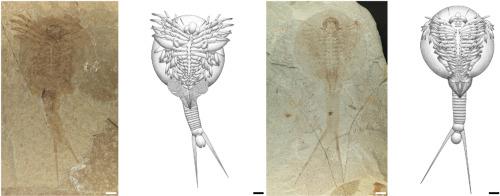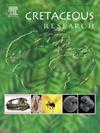内蒙古下白垩世notostracans新化石(鳃足目,Notostraca)
IF 1.7
3区 地球科学
Q1 GEOLOGY
引用次数: 0
摘要
Nototracans已经在地球上生活了3.5亿多年,但有限的物种记录和可怜的标本保存大大阻碍了我们对他们早期的进化历史的理解。本文补充了内蒙古多伦地区下白垩统易县组已知种的资料,并报道了Weichangiops trangularis Yang和Hong, 1980和Weichangiops squamosus sp. nov.的新种。根据保存完好的新标本,对Weichangiops Yang和Hong, 1980和W. trangularis的诊断特征进行了修订。这些新发现的化石标本使我们能够对Notostraca的形态特征进行详细的总结,并对白垩纪谱系中观察到的特征进行系统的回顾。考虑到白垩纪notostracan化石的相对稀罕性,这些发现不仅扩大了这一时期已知物种的多样性,而且为Notostraca的早期进化过程提供了有价值的见解。本文章由计算机程序翻译,如有差异,请以英文原文为准。

New fossil notostracans (Branchiopoda, Notostraca) from the Lower Cretaceous of Inner Mongolia, China
Nototracans have lived on Earth for over 350 million years, yet limited species records and poor specimen preservation have significantly impeded our understanding of their early evolutionary history. Herein, we supplement the information of a known species and report a new species, Weichangiops trangularis Yang and Hong, 1980 and Weichangiops squamosus sp. nov., from the Lower Cretaceous Yixian Formation in Duolun, Inner Mongolia, China. The diagnosis characters of Weichangiops Yang and Hong, 1980 and W. trangularis were revised based on the new well-preserved specimens. These newly discovered fossil specimens allow for a detailed summary of morphological characteristics in Notostraca, with a systematic review of features observed in Cretaceous lineages. Given the relatively rarity of Cretaceous notostracan fossils, these findings not only expand the known species diversity of this period but also provide valuable insights into the early evolutionary processes of Notostraca.
求助全文
通过发布文献求助,成功后即可免费获取论文全文。
去求助
来源期刊

Cretaceous Research
地学-地质学
CiteScore
4.10
自引率
19.00%
发文量
235
审稿时长
12 weeks
期刊介绍:
Cretaceous Research provides a forum for the rapid publication of research on all aspects of the Cretaceous Period, including its boundaries with the Jurassic and Palaeogene. Authoritative papers reporting detailed investigations of Cretaceous stratigraphy and palaeontology, studies of regional geology, and reviews of recently published books are complemented by short communications of significant new findings.
Papers submitted to Cretaceous Research should place the research in a broad context, with emphasis placed towards our better understanding of the Cretaceous, that are therefore of interest to the diverse, international readership of the journal. Full length papers that focus solely on a local theme or area will not be accepted for publication; authors of short communications are encouraged to discuss how their findings are of relevance to the Cretaceous on a broad scale.
Research Areas include:
• Regional geology
• Stratigraphy and palaeontology
• Palaeobiology
• Palaeobiogeography
• Palaeoceanography
• Palaeoclimatology
• Evolutionary Palaeoecology
• Geochronology
• Global events.
 求助内容:
求助内容: 应助结果提醒方式:
应助结果提醒方式:


